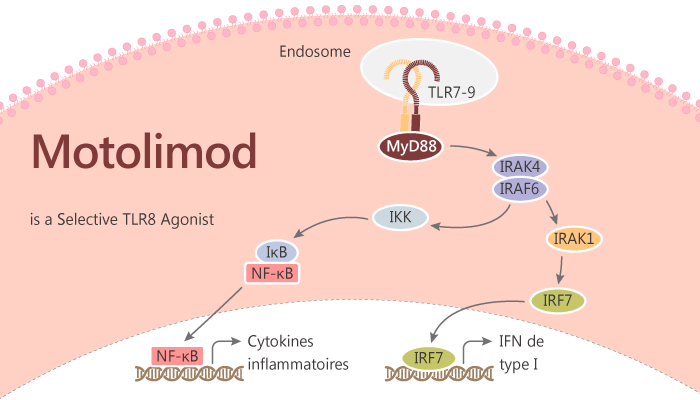Motolimod (VTX-2337) is a selective Toll-like receptor (TLR) 8 agonist.

In vitro, HEK293 cells with various human TLRs, only Motolimod activates TLR8, Meanwhile, Imiquimod and CpG ODN2006 selectively activate TLR7 and TLR9 respectively. In PBMCs, Motolimod stimulates TNF-α production with an EC50 value of 140 nM, And it also stimulates the production of IL-12 (EC50 = 120 nM).
To elucidate the cell subsets sources in PBMCs.
Motolimod (800 nM) stimulates the production of TNF-α and IL-12 in a high percentage of monocytes (59% ± 10% positive for TNF-α and 14% ± 4% positive for IL-12),it also promotes the production in mDCs (57% ± 8% positive for TNF-α and 15% ± 3% positive for IL-12). Whereas VTX-2337 does not stimulate IFN-α in pDCs.
To further determine the cellular source of the IFN-γ seen in activated PBMCs. It finds that VTX-2337 has a robust induction of IFN-γ in CD69+IFN-γ+ NK cells (10.6%) compared to unstimulated controls (1.1%). To determine whether IL-12 and/or IL-18 play a role in the activation of NK cells by VTX-2337, IL-12 and/or IL-18 neutralizing antibodies are used. IL-12 blockade does not affect Motolimod (0.8 μM) to induce IFNγ production. IL-18 blockade significantly deregulates IFN-γ production.
moreover, VTX-2337 stimulates IFN-γ production in purified NK cells to a level that is similar to in PBMCs from donors
Motolimod induces the secretion of both IL-1β and IL-18 in the absence of known activators of NLRP3 in PBMC and THP-1 cells.
In vivo, cynomolgus monkeys receive a subcutaneous injection of VTX-2337 (1 or 10 mg/kg). Motolimod increases mean plasma levels of IL-1β from baseline levels of 0.5 pg/mL, up to 9.12 ng/mL after administration. VTX-2337 also increases IL-18 production from baseline to 68.7 pg/mL. Motolimod induces inflammatory factors releases independent of NLRP3 inflammasome activation.
In summary, Motolimod (VTX-2337) is a novel, potent, and selective smallscale TLR8 agonist. It can directly activate mDCs, monocytes, and NK cells. Motolimod actives immune factors coordinated with NLRP3, augmenting the ADCC of tumor cells by mAbs in NK cells 。
reference:
Lu H, et al. Clin Cancer Res. 2012 Jan 15;18(2):499-509.
Dietsch GN, et al. PLoS One. 2016 Feb 29;11(2):e0148764.